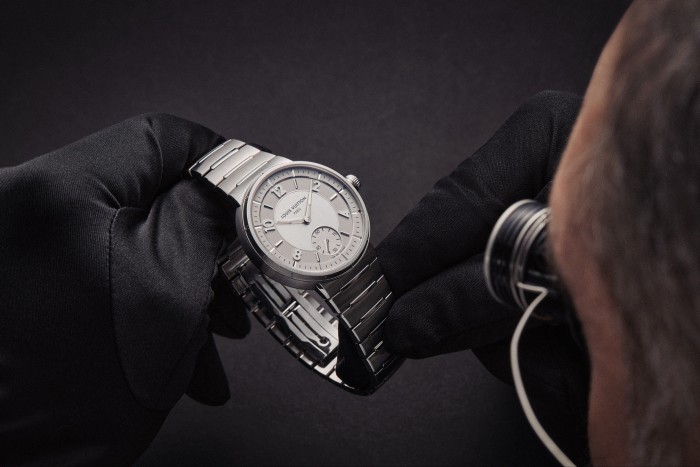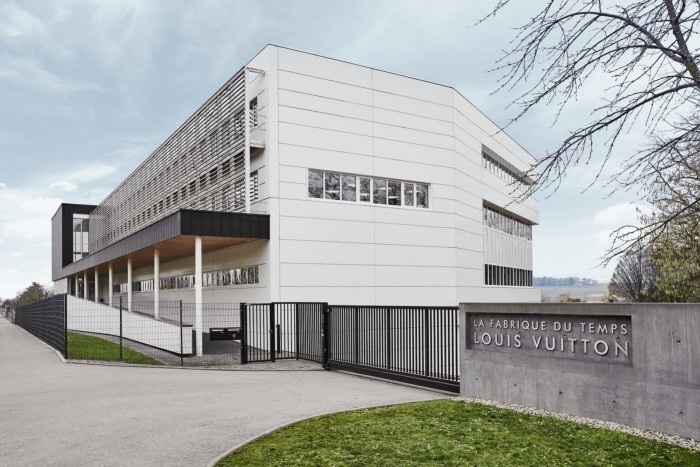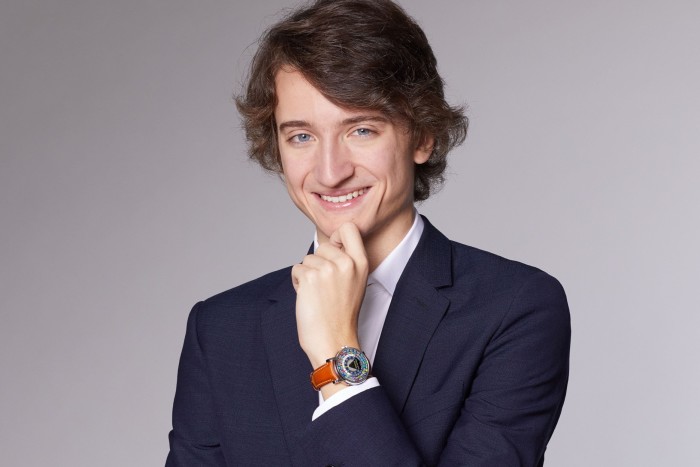Louis Vuitton redesigns Tambour watch after shift to boutique horology model

Roula Khalaf, Editor of the FT, selects her favourite stories in this weekly newsletter.
Jean Arnault is learning the ways of watches fast. Not quite two years ago, this youngest of LVMH founder Bernard Arnault’s children joined the watch division of Louis Vuitton. Now, the 24-year-old is taking steps to completely relaunch the brand’s watch offer.
On Wednesday, he presented a new Tambour integrated bracelet steel sports watch, priced five times higher than the average mechanical watch sold by Louis Vuitton. At the same time, Arnault quietly retired around 130 existing product lines.
It is no secret that Arnault is fascinated by watches, way beyond the role they play in the family’s luxury goods empire. He loves watchmaking with the passion of a collector. He has established a prize fund to benefit young watchmakers, and he has taken the Daniel Roth and Gérald Genta brands out of the Bulgari ambit to position them as low-volume, high-value watchmakers that reflect the prevailing fashion for independent watchmaking.
All the while, he has been planning a new-look Louis Vuitton watch offer. When he took over, the LV watch range consisted of 300 different products. When it comes to LV’s watch inventory, Arnault talks of SKUs — stock keeping units. “This summer we’re removing about 130 men’s SKUs and introducing five SKUs, with other collections coming in the future,” he says.
By 2025, he expects a similar change to have taken place in the women’s collection as well. “The idea is for us to grow from being an accessory in the overall collection, into being proper pure player watches.”
Until now, LV’s watch production — if not including the brand’s connected watch — has been mixed. It has ranged from haute horlogerie costing €500,000, to €2,500 models that are assembled with bought-in components at La Fabrique du Temps, the brand’s watch factory in Geneva.
Within two years, Arnault expects to have almost everything, including all cases and dials, made in house at La Fabrique du Temps, where staffing levels have risen steeply to facilitate this change. “When I arrived, we were fewer than 100; now we are about 180 or 190,” he says.

Even so, production will drop dramatically “from over 10,000 to under 2,000” available at fewer than 100 rather than 250 current LV stores. “We will become a real boutique horology brand,” Arnault says, expressing his hope that the perceived quality increase will justify a jump in average price from €4,500 to €22,000.
The Tambour is LV’s signature drum-shaped design. Introduced in 2002, it changed little over time. Now, about the only thing that remains the same is the name. The old Tambour was a chunky tub of a watch with tapering case walls boldly engraved with the brand name, and statement lugs. The latest iteration, however, is at most unrecognisable.
The new watch is 8.3mm high, compared with the original 13.2mm. The case walls no longer funnel from bottom to top and the inflection point is about two-thirds of the way up the case. The name does appear on the top part of the case wall but is so subtle that you have to look for it. The lugs, while not invisible, are so closely integrated into the supple bracelet as for it to be debatable where the bracelet ends, and the watch head begins. The micro-sandblasted and silvered dial with two-part chapter ring, and sub seconds at six o’clock, has a quiet sense of quality about it.
It is a watch that Arnault would like to appeal to non-Vuitton customers, and regret is audible in his voice when he discusses distribution. “For me, being part of Vuitton is a blessing and a curse,” he says. The curse has to do with LV watches only being available in LV stores, therefore limiting distribution compared with other brands found in retailers. “There’s also the fact that, obviously, we have the brand name, which is not known for watchmaking. But, on the other hand, we do have the chance of having significant investment in manufacturing resources, product design and engineering, which allowed us to go in very high from the start.


“When we launched Tambour in 2002, the positioning was significantly higher than what you would expect from a fashion house. Arguably, we haven’t increased the pricing or changed and evolved within the watch industry fast enough, but we’re doing it now.” Arnault is aiming to compress two decades of evolution into two years.
It is certainly a bold move. Whether LV watches can make the transition from megabrand accessory sector to bona fide timepiece, with what Arnault likes to describe as “pure player” credibility, is very far from certain. Even he is prepared for what he calls a “mixed” critical response. “But, internally, it was clear that, as soon as we saw the product, this was the direction we needed to go in, regardless of initial reception,” he says.
The strategy is also less risky than it might appear. First, even including the connected watch, timepiece sales account for no more than 3 per cent of LV’s revenue — so, even drastic changes are unlikely to adversely affect the health of the brand. Second, Louis Vuitton has its own very loyal collector base. Arnault himself says he was inspired to raise the quality of the watchmaking by the brand’s famous trunks. “It’s a show of craftsmanship that I felt watchmaking was lacking a little bit,” he says. “It’s not something we could have done, let’s say, four or five years ago, because we didn’t have the expertise or the confirmation from our clients that our high watchmaking was perceived well.” The brand has since picked up awards at the GPHG — the Oscars of the watch industry.
But, while undeniably radical, this sort of accelerated evolution in both design and pricing is not entirely without precedent. In 2004, Hublot was a lacklustre brand with an average price of €2,000, annual sales of fewer than 10,000 units, and a design little changed since the 1980s. That was the year Jean-Claude Biver joined the company. The following year, he discontinued the existing range and launched the radically different and considerably more expensive Big Bang model. Orders increased threefold in just one year. LVMH acquired Hublot in 2008.
Although Arnault may not have another Big Bang on his hands, he has his ambitions. “Watches,” as he constantly tells his staff, “will never be the largest category in the brand, but they can be one of the most desirable.”
Comments